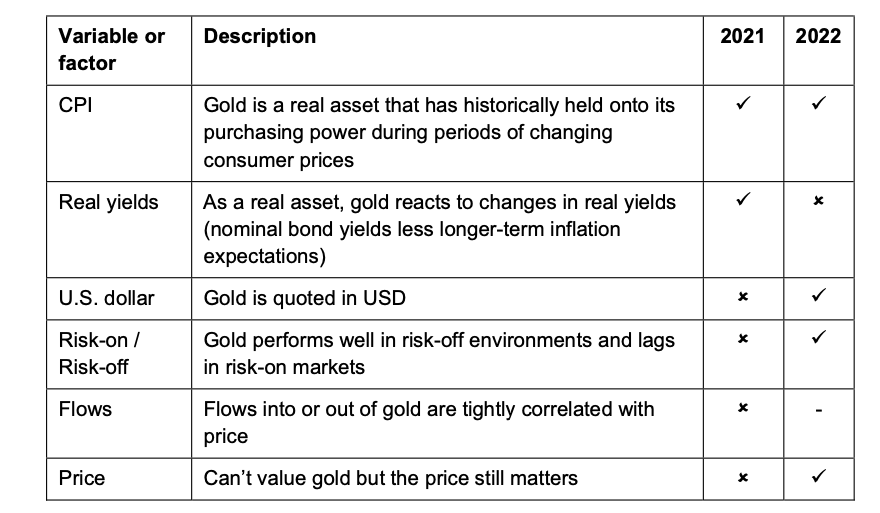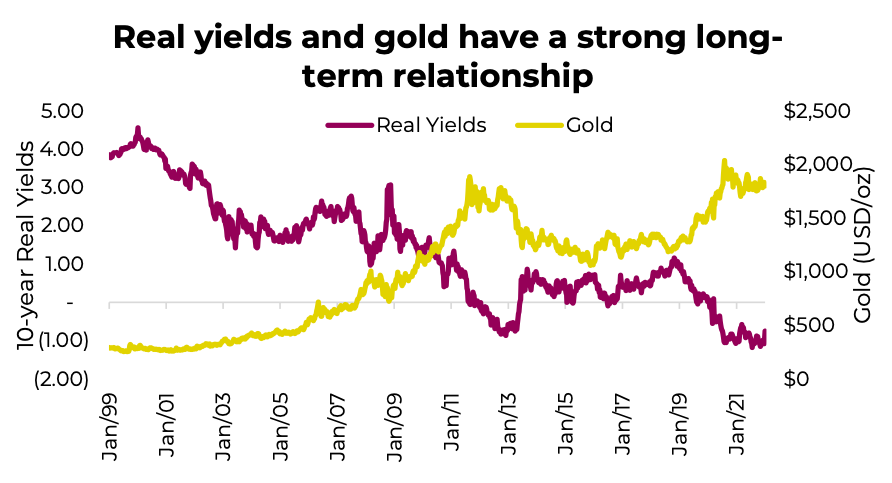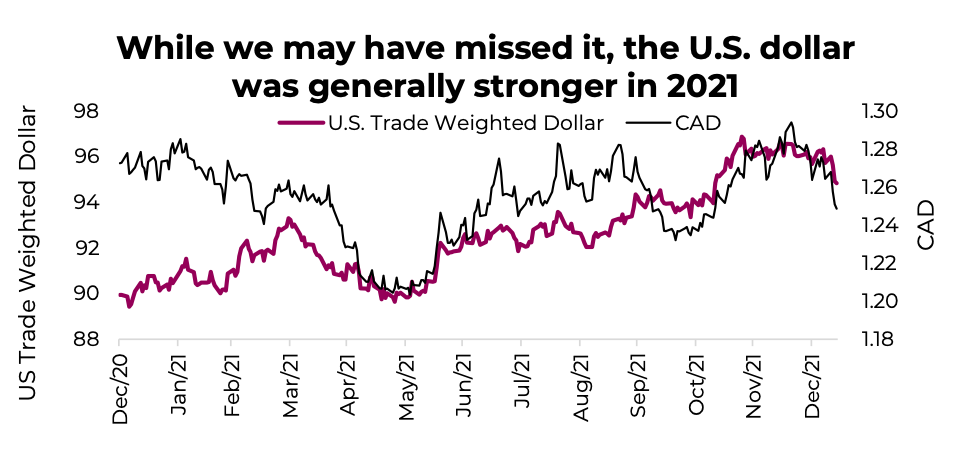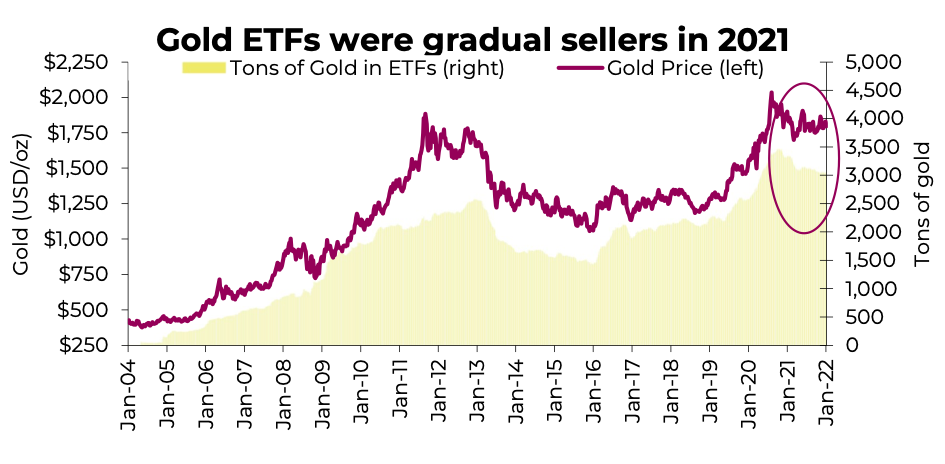Hit the rewind button back to a year ago. Gold was trading at $1,850/oz, and the iShares TSX Gold ETF was about $19.50. Now, how would you have responded if you were asked how gold and gold equities would perform in a year that would see:
- The pandemic getting worse.
- U.S. & Canadian Core Consumer Prices rise by 5.5% & 2.9%, the fastestpace since the early 1990s, causing inflation to become a hot topic.
- Real yields remain pinned below zero.
- Meanwhile, expansion in the global money supply would continue growing.
As humans, we love x → y, or simply, causality. It makes our lives easier – simple rules to help the decision-making process. Such as if there’s inflation, gold is good; everyone knows that one. Unfortunately, causality rarely has only one variable in the world and especially in the financial world. This was the long version of ‘it’s complicated.’ Gold isn’t broken, and there are many other variables at work. So, let’s go through some of the big ones to help put 2021 into perspective and see if we can get a handle on the outlook for gold in 2022.
Gold Price Influencers

CPI: Gold has a good long-term track record of being a real asset that holds onto its value during periods of elevated inflation (currency losing purchasing power). This was most recently cemented back in the 1970s as inflation really took off and so did gold. It’s worth noting though, many years in the 1970s saw CPI accelerating and gold falling. It may be a strong general relationship, but other variables may become the driving force for periods. Perhaps 2021 was one of those periods.
Nonetheless, the highest CPI since the early 1990s was undoubtedly a positive factor for gold in 2021. The big question is what will happen in 2022. The bottlenecks contributing to higher CPI should gradually abate. Covid supply disruptions, strong demand and abruptly changing behaviours should all ease. But so much stimulus has been injected into the global economy which will continue to impact prices for many quarters to come. Headline CPI is likely to normalize in 2022, but this new normal will likely be higher than pre-pandemic. And the longer it lasts, the more expectations about the future change. This is positive for gold.
Real yields: The benefit of discussing real yields is that it incorporates nominal yields and longer-term inflation expectations (not to be confused with headline CPI data). In isolation, higher nominal yields are not good for gold. Bonds are a competing asset class, and more yield increases the opportunity cost of holding gold, which has no yield. As a result, the rise in nominal yields has been a headwind for gold over the past year.

Fortunately, the longer-term inflation expectations (measured by breakevens) have been rising as well, and this has kept real yields (nominal less inflation) negative. That has been good for gold, but only marginally. The change in real yields matters more so than the absolute level. Gold really likes it when real yields are falling versus when they are stable.
Let’s give real yields a shout-out as a positive contributor for 2021 since they remained negative. For 2022, this gets a bit more uncertain. We believe nominal yields will continue to trend higher in 2022 but do not believe they will accelerate meaningfully. Simultaneously, inflation expectations are likely to rise as well as we are seeing sticky priced items starting to rise, company intentions remain elevated for further price increases and wages ticking higher. Put this all together, and real yields will likely stay below zero. But we are going to give this an for 2022. This is partly due to the negative starting point, and we could see nominal yields potentially rise faster than longer-term inflation expectations.
U.S. Dollar – This one is pretty clear: gold is priced in U.S. dollars. So, if the U.S. dollar rises, the quoted price of gold tends to fall.
In 2021, the U.S. dollar did rise against most currencies. If you only watch the CAD$, you may have missed this, given the strength in the loonie during the same period. It remained flat against the US$ but rose against many others.

The rising U.S. dollar was a headwind for gold in 2021; that is an in our gold influencers table. As we move into 2022, with central banks expected to pivot at different times and speeds, currency volatility will likely elevate. More major currencies are undervalued versus the U.S. dollar than overvalued, with a number expected to raise rates sooner than the Fed. And while periods of dollar strength are expected in risk-off periods, the longer trend is likely lower. We will give currency a .
Risk-on / Risk-off: So, gold performed somewhat poorly in a year that North American indices rose 25+%. Pretty sure a raging bull run is not when gold shines. It is a safe haven asset, and in a year where investors were chasing outsized returns, gold dulls. If your defensive assets went up 15-25% last year, best to check your classifications, as those are likely not really defensive.
2022 has a lot of significant moving parts for the market to digest. The changing pace and, in some cases, direction of monetary and fiscal stimulus will be a big one. Add in the potential of changing leadership that’s currently being debated in the markets, and this year will likely be a bumpier ride. This could lead to some risk-off periods and, given how far markets have advanced over the past twenty months, safe haven assets may be opportune. So, it is for 2022.
Flows: As with any asset, net inflows tend to help the price and outflows hurt. In this case, our proxy is the changes in gold held by ETFs (chart). We could debate whether it is a change in price that drives ETF net flows (classic performance chasing), the flows causing the price change or a combination of the two. This connection has become stronger during the past decade or so.
After strong inflows in 2020, gold experienced gradual outflows in 2021. If you take a step back, this is logical. Much of the inflows in 2020 were driven by the extreme uncertainty of the pandemic; call it a safe place to park capital. As uncertainty declined and markets rose, the money was re-allocated back to whence it came. It sounds simple, but often things are.

Did digital assets steal the flows? (aka bitcoin and friends). Maybe some who dislike the gradual (sometimes a bit faster than gradual) decline of purchasing power of fiat currencies have opted to move from gold to digital assets. But we are pretty convinced their flows are because of risk-on behaviour. Gold is a safe haven real asset. Digital assets may be that someday, but remain a high risk/reward asset for now.
Flows in 2022 could go either way. Digital assets may continue to lure some capital out of gold. On the positive side, more than half the money that piled into gold as the pandemic fear peaked has been pulled back out, and the pace of outflows has slowed to a trickle in recent months. We will give our outlook for flows as neutral for the coming year.
Price: Sadly, it is challenging to try and value gold. An old economist friend often said gold is valued as 1 / T, where T is trust in the system. We have also heard that an ounce of gold should always buy a nice men’s suit on Savile Row. Neither is exactly hard data for analysis. It also brings in the level of uncertainty again. We could even simplify more, as gold went up 18% in 2019 and 25% in 2020. In other words, it started 2021 at an elevated price level with some big gains to digest. We don’t know if gold is cheap or expensive as we head into 2022, but we do know after dropping 4% during the year, perhaps it has digested or consolidated after those big previous calendar year returns.
Investment implications
Anyone who has invested in gold for more than a few years has likely been frustrated at one point or another. There are many moving parts to gold, and sometimes one factor or influencer matters more than others, and the ones that matter most change with time. Maybe real yields will be the primary driver this year, maybe the U.S. dollar or maybe flows. What we do know is more of these factors are better positioned for a positive contribution to gold as we head into 2022.
And let us not forget that owning gold usually provides a safe haven asset. What if we get a risk-off period, which could be driven by slowing growth, the flare-up of a conflict on the Eurasian plain or any other reason? If the bottlenecks in the supply chain remain, that could see nominal yields fall while inflation doesn’t. The U.S. dollar would rise, offsetting some of the positive impulses for gold, but the net impact would likely be pretty good.
Gold isn’t broken. It behaved like a safe haven asset should, in a year that was predominately risk-on. Given our outlook on the breakdown of input factors, we continue to believe an allocation to gold is a prudent part of a portfolio.
Sources: Charts are sourced to Bloomberg L.P., Purpose Investments Inc., and Richardson Wealth unless otherwise noted.
Twitter: @ConnectedWealth
Any opinions expressed herein are solely those of the authors, and do not in any way represent the views or opinions of any other person or entity.







